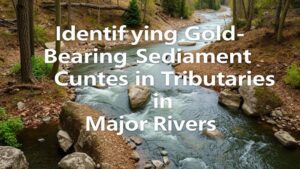How to Use Natural Rock Shadows as Clues to Buried Gold Deposits
How to Use Natural Rock Shadows as Clues to Buried Gold Deposits
The search for gold has captivated human interest for centuries, leading countless prospectors to brave the wild and remote areas in pursuit of hidden riches. While modern prospecting often relies on advanced technology, a more traditional method involves observing the natural landscape, particularly rock shadows. This article will explore how natural rock shadows can serve as significant clues in locating buried gold deposits, presenting a combination of geological knowledge and practical tips to enhance your prospecting efforts.
The Science Behind Rock Shadows
Rock shadows are cast by natural formations during daylight hours, particularly when the sun is low in the sky. Understanding how these shadows behave is crucial for prospectors. Shadows can indicate the underlying geological features and help identify areas where erosion may have deposited gold-bearing materials.
- Shadow Length: Longer shadows during sunrise and sunset may reveal the shape and size of rock formations.
- Shadow Orientation: The direction of the shadow can signal the underlying structure of the geology, such as faults or folds that can trap gold deposits.
- Seasonal Changes: Shadows will vary with seasons; hence, they must be assessed at different times of the year to gather comprehensive data.
Identifying Potential Gold Locations
To utilize natural rock shadows effectively, prospectors should consider several key indicators that may point to potential gold locations:
- Proximity to Water: Gold is often found near riverbeds or streams. Shadows cast by rocks near water sources can reveal areas where erosion has occurred, potentially exposing gold deposits.
- Geological Formations: Shadows of rock outcroppings may indicate formations known to contain minerals such as quartz, which is often associated with gold. Understanding the geological history of the area can help identify promising sites.
- Vegetation Patterns: Areas where shadows persist might exhibit different vegetation that can indicate underlying soil changes, often correlated with mineralization.
Case Studies: Successful Prospecting Using Shadows
There are numerous instances where prospectors have successfully utilized natural rock shadows to locate gold deposits. One noteworthy example occurred in the Sierra Nevada mountain range, where prospectors observed specific shadow patterns cast by granite formations during different times of the day.
By mapping these shadows and their corresponding geological features, prospectors were able to focus their efforts on specific locations that not only displayed geological complexity but were also adjacent to ancient river paths where nuggets were later discovered.
Combining Techniques for Enhanced Results
While observing rock shadows can be beneficial, combining this method with other prospecting techniques can yield even better results. Consider the following approaches:
- Soil Sampling: Collect soil samples in areas indicated by shadow analysis to identify the presence of gold particles.
- Geophysical Surveys: Utilizing electromagnetic surveys can help detect subterranean anomalies associated with gold deposits, which can be correlated with shadow patterns.
- Mapping and GPS: Documenting locations of significant shadows with GPS mapping can establish a clearer picture of potential hotspots over time.
Tips for Effective Shadow Analysis
To maximize the effectiveness of your shadow analysis, keep these guidelines in mind:
- Timing is Key: Conduct your observations around sunrise and sunset to capture the most pronounced shadows.
- Use a Compass and Map: Know the cardinal directions as shadows shift throughout the day; this will help you orient your findings.
- Document and Review: Keep a detailed notebook of your observations over time to establish patterns and correlations.
Conclusion: Practical Applications in Modern Prospecting
In summary, natural rock shadows provide valuable clues in the quest for buried gold deposits. By understanding and analyzing how shadows interact with geological formations, prospectors can refine their focus, enhance their searching strategies, and potentially increase their chances of success. Whether you are a seasoned miner or a budding enthusiast, integrating shadow analysis into your prospecting arsenal can lead to more fruitful endeavors.
Successful prospecting often relies on a blend of traditional knowledge and modern technology. So, embracing the wisdom of natural indicators while leveraging contemporary methods may reveal hidden treasures awaiting the determined adventurer.


